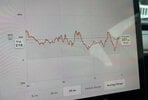Amazing how much battery degradation varies when everyone has the same batteries
I mean your car is almost 6 years old with 76k miles and has only lost a little over 10 miles while mine is 1.5 years old with 27k miles and has lost almost 30
Your way above the average going by the Tessie app, I’m slightly below the average by like .5%
Ha. And there's more to this than you might think.
Back in the day the SO and I had a 2018 M3 LR RWD that, over the year and a half since we had it, had gone from about 320 mile range (figured by dividing the displayed mileage by the %charge) to about 290 miles or so. And I was sad.
At that time, we decided to take a lengthy trip from NJ down to Savannah, GA, to check out the birthplace of the Girl Scouts in the US. This involved, more or less, getting on I-95 southbound and hitting Superchargers as we went, staying overnight in the middle somewhere. We left with a full charge (recommended for this kind of thing) and were, more or less, following the NAV, charging roughly three times on the way down. Note that this resulted in some relatively rapid, deep discharges of the battery.
And, wonder of wonders, the max range crept right back up into the 320's. And stayed up there for the next three or four months, then started creeping back down again.
And that got to be a generally observed process. Don't drive long distances; charge the car when it hit 30% or so to 80% or so; and, over time, the indicated max range would creep down into the 290's. Go on a longish trip with multiple deep discharges; and the indicated range would go right back up again. The car was sold in 9/2023 and had a max range, at the time, of 308-310 miles, which was pretty good for a five year old Tesla.
The issue is that the BMS tries to figure out how much energy is stuffed into the battery. Compared to an ICE, it does a decent job; but it does accumulate some error in there.
There are occasional threads around the TMC (and other places) where people hit upon this-method-or-that to "recover" those lost miles; most of those methods involve stuff like discharging the car down to 2%, then back to 95%, and lather, rinse, repeat, say, 3 times. Which is like a thousand miles of driving.. to recover "lost" mileage of 20 or 30 miles or so. I figure it's not worth the effort.
So, don't take that "battery degradation" as gospel. Yeah, some people
do get batteries that go down for the count; but with most, it's probably just BMS inaccuracy.




